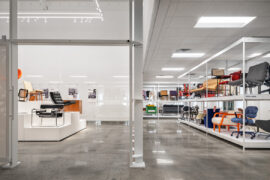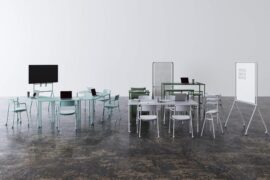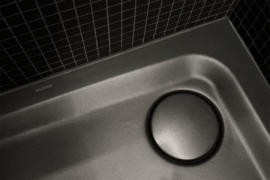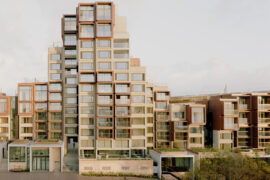As Japan’s Kokuyo Furniture Company expands across Asia, it tweaks its designs to suit the preferences of different markets. Its attentiveness to culture and work habits is earning it praise. Narelle Yabuka reports.

February 15th, 2013
It makes a lot of sense that the diversities of Asia’s various cultures translate to different preferences in design – even for an object as utilitarian as the office chair.
In recent years, Kokuyo – one of the top players in Japan’s office furniture arena – has expanded its operations to China, Hong Kong, Thailand, Malaysia, Singapore, India and Indonesia. And in each of these locations, it has discovered nuances that require particular design responses.

The faces of Kokuyo Furniture – (left to right) Toru Hagiwara (Managing Director of Singapore Branch), Kozo Sakagami (Director of Overseas Business), and Hidekuni Kuroda (President and CEO). Photo by Luo Jingmei
“Japanese people prefer smaller-sized furniture,” says Kozo Sakagami, Kokuyo Furniture’s Director of Overseas Business. “In China and wider Asia, people prefer larger proportions,” he continues.

Airfort chair – Kokuyo’s best-selling piece of furniture across the world
Adds Toru Hagiwara, the Managing Director of Kokuyo Furniture’s Singapore Branch, “We try to find the right balance between design and function for every market.”
He explains, “Japanese people prefer a very simple style. But in greater Asia and Western countries, people tend to prefer the functional aspects of the furniture to be more prominently displayed in the design. For example, the air pump in the lumbar support system of our Airfort chair.”

Airfort chair
“Initially,” says Hidekuni Kuroda, President and CEO of Kokuyo Furniture, “we designed Airfort only for the wider Asian market, but now we’re selling it in Japan too due to demand. It’s our best-selling chair all over the world.”
Kokuyo tweaks the specifications of its furniture to give it optimum suitability to each market. Seat height is an example. “The Japanese standard is very low,” says Sakagami. “China uses the British standard, which is a little higher.” Notes Hagiwara, “There’s also a preference for leather in China.”

Epiphy table – a collapsible and stackable table designed to never catch hands
Attentiveness to the needs of the users of its products is certainly being appreciated. In 2012, Kokuyo was named one of the top 10 most trusted brands in Guangzhou in a poll held by the Chinese edition of Interior Design magazine. It was the only furniture company in the top 10.


Epiphy table
Kokuyo relates its success to its ’people plus design’ philosophy, and its focus on innovation, sustainability and quality. Aside from paying close attention to aspects such as ease of use, safety, durability and flexibility, Kokuyo keeps an eye firmly on changing work styles.

Epiphy table
Says Hagiwara, “Every product is innovative. When we design new products, we try to focus on what is going to happen to our clients’ working styles. We try to make new products that will allow the client to work in new ways.”
For example, products are designed that allow a more efficient use of space, and provide more options for use.

Softorage cabinets – with a buffering closure mechanism that prevents noisy slamming of its doors
With its 100-strong team of interior designers in Japan, Kokuyo is well placed to keep abreast of changes in the workplace. Its design team undertakes interior projects in a variety of sectors in Japan, ranging from commercial to medical and hotels.

Softorage cabinets
Last year, the company opened its own share office space in Shibuya, Tokyo. Called Creative Lounge MOV, it is a space that can be rented by anyone for various periods – from a day to a year. It is attracting many clients from the creative industries, and addressing a much-needed service for those with changeable work routines in a city with notoriously high property prices.
Of course, it is fitted with Kokuyo furniture and delivers a message of the Kokuyo brand’s understanding of and engagement with its customer base. No doubt, such spaces would be successful in other Asian cities where changes in work culture are not addressed by rental practices.
Kokuyo
kokuyo.com.my
INDESIGN is on instagram
Follow @indesignlive
A searchable and comprehensive guide for specifying leading products and their suppliers
Keep up to date with the latest and greatest from our industry BFF's!

The undeniable thread connecting Herman Miller and Knoll’s design legacies across the decades now finds its profound physical embodiment at MillerKnoll’s new Design Yard Archives.

Welcomed to the Australian design scene in 2024, Kokuyo is set to redefine collaboration, bringing its unique blend of colour and function to individuals and corporations, designed to be used Any Way!
Say goodbye to rickety cafe tables with this clever new table base from Echelon.

Siriyot Chaiamnuay and Arisara Chaktranon, the founders and Design Directors of Thai studio Onion, craft spaces that have the power to affect deeply.
The internet never sleeps! Here's the stuff you might have missed

Overlooking Berlin Zoo, the suites of the 25hours Hotel Bikini Berlin curate the sustainability ethos in an entirely unique and dynamic aesthetic. Think natural fabrics and materials, jewel-hued colours, curves and cushions, spa-like bathrooms and hammocks with views over urban greenery.

Following the launch of Carr’s Brisbane studio, Director Richard Beel has permanently relocated to lead the practice’s growth across Queensland — supported by a local leadership team and a growing portfolio of projects ahead of the 2032 Olympic Games.

BVN’s Sirius Redevelopment has been named one of two joint winners of The Building category at the INDE.Awards 2025. Celebrated alongside Central Station by Woods Bagot and John McAslan + Partners, the project reimagines an iconic Brutalist landmark through a design approach that retains heritage while creating a vibrant, sustainable future for Sydney.